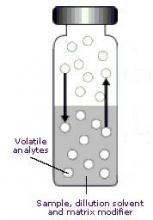Data provider
Budapest University of Technology and Economics, Department of Applied Biotechnology and Food Science, Environmental Microbiology and Biotechnology Group
Contact details
Compulsory sheet
Contaminants
- Benzene and alkyl benzenes (BTEX)
- benzene
- Volatile (nonhalogenated) organic compounds
- p-cresol
- Halogenated aliphatic organic compounds
- trichloroethylene
- Halogenated aromatic organic compounds
- 1,2-dichlorobenzene
Feasibility of the method
Implementation conditions
Implementation costs
Innovation, main features
A folyadékkal érintkező gáztérben a folyadékban oldott illó alkotók emelt hőmérsékleten a megoszlási egyensúlynak megfelelően feldúsulnak, így a gőzből vett mintát tudjuk gázkromatografálni. Megfelelő kalibrációval a gőztérből vett minta kromatogramjából az adott komponens koncentrációja a bemért szilárd vagy folyadék mintában kiszámítható.
illékony szennyezőanyagok mérése talajban, talajvízben, hulladékban
csak illékony (forráspont <200°C) szerves vegyületek mérésére alkalmas
A gőztér analízis mintatartó edénybe bemérünk 100 mg-1g szilárd vagy 100 ul-5 ml folyadék mintát, a szilárd mintához alacsony gőznyomású folyadékot adunk, majd az edényt adott ideig termosztáljuk, a mintavétel a gázkromatográfba autómatikusan történik.
SWOT (evalaution based on scores)
SWOT (evaluation in words)
Gyors módszer, minimális mintaelőkészítést igényel.
Kevesebb paraméterrel dolgozik, mint a dinamikus gőztéranalízis, ezért egyszerű a fejlesztés.
A folyadékinjektálással szembeni hátránya, hogy egy minta gőzterét csak egyszer lehet gázkromatografálni. A gáztömör fecskendővel végzett mintavétel után ugyanis megváltozik a gőzösszetétel, és az újabb egyensúlybeállás már nem az eredeti és meghatározandó folyadékösszetételhez rendelhető.
A fecskendős mintabevitel nyitott rendszer, amíg be nem ér a minta az injektorba.
Ha pillanatszerűen vesszük a mintát, akkor vákuum alakulhat ki a tűben, ami az injektálásig megszívhatja magát a labor levegőjével.
A HS-GC nem olyan érzékeny, mint a szilárd fázisú mikroextrakció (SPME) vagy a dinamikus Headspace (DHS).
Other information, references
MSZ 1484-4 és-5: 1998; MSZ 21470-92 és-93: 1998; EPA 8260 és 624; MSZ 21470-94:2000; MSZ 21470/78-1989;
Fenyvesi, É.; Balogh, K.; Bátai, B.; Gruiz K.: Ciklodextrinek alkalmazási lehetőségei klórozott vegyületekkel szennyezett területek remediálásában, Országos Környezetvédelmi Konferencia Siófok 2008. szeptember 16-18., 107-117. o.
Completed applications
A triklóretilén fényre bomlik, ezért hűtőben és fénytől védett helyen kell tárolni a mintákat, amelyeket lehetőség szerint minél hamarabb meg kell mérni.
